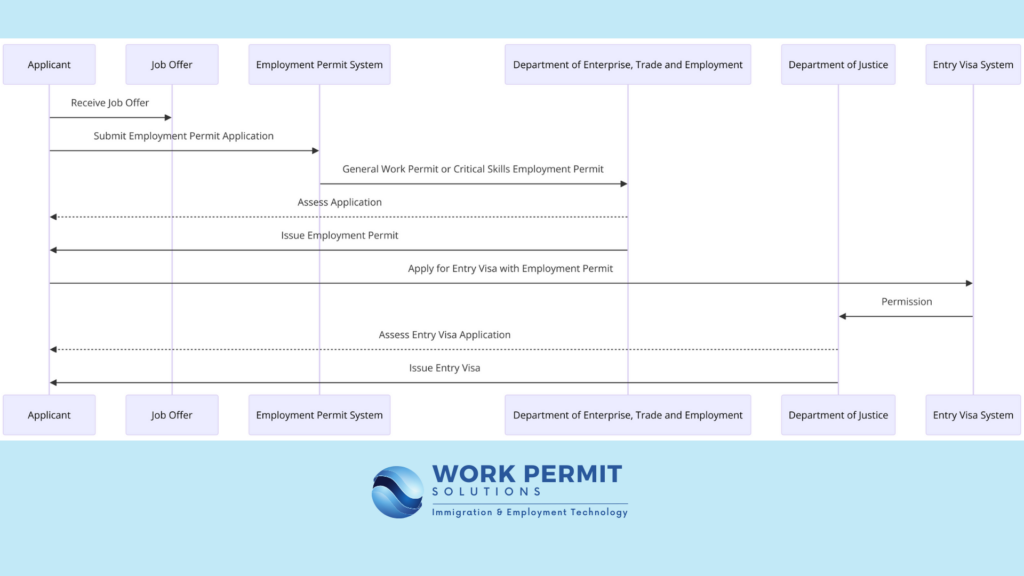I’ll cut to the chase with this one. Employment permits are complex, cumbersome, and enormously time consuming, despite our responsible use of generative AI for some parts of the process. Were this not true, our business model would be obsolete, and you likely wouldn’t be reading this right now. Kindly note that “I” and “we” are used in a conscious manner, in that “I” am the one writing the article and “we” are Work Permit Solutions Ltd.
The vast majority of businesses we speak with have very little knowledge of how employment permits and immigration processes work, and our findings paint a vivid picture; they have neither the will nor the time to figure it out. Bearing this in mind, we thought it would be beneficial to explain some of the nuances.
Here are two example case studies:
Case Study 1:
A company, already at breaking point due to unprecedented demand, hires 2 non-EEA nationals for crucial roles. Unfortunately, they have little understanding of the permit process. Their initial application is swiftly rejected at the automated pre-check stage for reasons that leave them scratching their heads. After a painstaking review and resubmission, the application clears this hurdle, only to be rejected again five weeks later for reasons that remain frustratingly ambiguous. Three refusal explanations are provided, which allows them to take their pick more or less.
The result? A significant loss of time and money—circa €1,000 in advertising and €2,000 in rejected application fees. Application fees will be refunded but this fails to remedy the situation.
Case Study 2:
Another company, struggling with staff turnover due to a new competitor nearby, hires five non-EEA nationals to maintain their output levels. They submit the permit applications, assuming it’s just another routine form filling exercise. While the applications initially pass the pre-check, they’re ultimately rejected six weeks later. The reason? Incorrect forms were submitted. With the applicants’ Irish Residence Permission cards expiring in a fortnight, anxiety levels surge, adding pressure to an already strained management team.
A sense of panic ensues, and work-related stress begins to creep up.
There are information lines that can be called, but 95% of the time, your question will not be answered directly. Besides some very general information and a few dead website links, you’ll find that help is not exactly within arm’s reach.
Both scenarios contribute generously to fatigue, burnout, and a significant drop in morale. A position no company wants to be in.
These are the reasons why WPS was created. To provide solutions for intricate problems like this. We are an Irish company that understands talent attraction, sourcing, acquisition, and retention like few, arguably any other immigration agency. The very concept of WPS was extracted from commercial recruitment and has indeed stood us in very good stead.
Let’s have a look at employment permits from a broad overview. The Irish government prioritises hiring from within the European Union’s workforce. However, when specific skills are scarce within this pool, it may consider employing non-EEA nationals to address these shortages, provided it supports Ireland’s economic or social progress.
The approach to issuing employment permits is responsive to the country’s economic climate. During economic growth, the range of occupations eligible for permits expands to accommodate the needs of a growing economy (hence December’s announcement) and address labour and skills shortages. Conversely, in economic downturns, the list of eligible occupations is reduced, and additional restrictions may be implemented to align with decreased job opportunities and an excess of available workers.
Although non-EEA nationals play a role in filling labour market gaps in Ireland, this strategy is not viewed as a permanent fix. The primary focus remains on hiring, training, and employing Irish and EU citizens. This was outlined in the most recent call “Ireland needs you to help us build homes” uttered by Higher Education Minister Simon Harris, who has recently created outreach campaigns in various countries in a bid to urge Irish construction workers to return home. In addition, various schemes incentivising the uptake in apprenticeships have been rolled out.
Migration is seen as a temporary measure to supplement the government’s main goal of enhancing the skills of the domestic workforce. Policymakers are aware that relying on migration could inadvertently maintain skills shortages by diminishing the incentive to develop these skills domestically.
However, from a fiscal standpoint, employment permits are not inconsequential; they represented a revenue of €40 million in fees for the Exchequer last year alone.
Now let’s shift our attention to the nitty-gritty, nuts, and bolts aspect of employment permits.
For Irish employers, visas, stamps, permissions, IRP Cards and permits are all construed as the same thing. If you had previously shared this thought, you’re not alone. Each respective term means something unique, and they are often confused to the extent that the Irish Court system mixes them up.
Here’s a breakdown:
A Permission: Apex of the immigration pyramid, the legal basis on which the non-EEA National is present in the State.
Visa: A visa is nor more than a permission to seek Leave to Land, or in simpler terms, entry into the State. It is defined as an inscription or an endorsement (make of that what you will) placed in the passport or travel document other than that of an Irish passport or travel document. It can be a sticker, a passport stamp, or a handwritten inscription placed by an immigration control officer.
Stamp: Despite already mentioning the word stamp, it has its own meaning. A stamp is simply a representation of the underlying Permission, normally shown under the “Remarks” section of an IRP Card
IRP Card: Formerly known as GNIB Cards, they are a plastic card which show the type of Permission the holder has and the expiry date. These can be complicated in the sense that they do not always represent the accurate version of the underlying Permission.
Permit: Normally issued as an Employment Permit, this document represents the type of permit that has been issued to the applicant, e.g., a Critical Skills Employment Permit.
Residence in the state of non-EEA nationals in possession of an employment permit is a joint responsibility between the Department of Enterprise, Trade and Employment, and the Department of Justice. Once the former issues the permit, the non-national is issued with a Permission by the latter.
Presently, the process is as follows:
- Labour Market Needs Test: 4 weeks (General Employment Permits & Contract for Services Employment Permits – not required for Critical Skills)
- Processing times: 5-6 weeks
- Entry Visas: 6-8 weeks (for non-EEA nationals from visa-required countries)
The quickest route is the Critical Skills Employment Permit for those not requiring an entry visa (5-6 weeks), while the most prolonged path involves a General Employment Permit for visa-required non-EEA nationals (up to 18 weeks).
The new overhaul plan announced by Minister Neale Richmond aims to completely restructure the existing system, which is a two-stage process run by the aforementioned departments.
This transformation, although welcomed, will shorten, but not erase the administrative demands or complexity in relation to entry visas and employment permits. Here, the expertise of WPS becomes invaluable. We manage the entire process from start to finish, allowing you to return your focus where it truly belongs—on your business.
Reach out to us, and together, let’s make your next application smooth and simple, as it should be.

